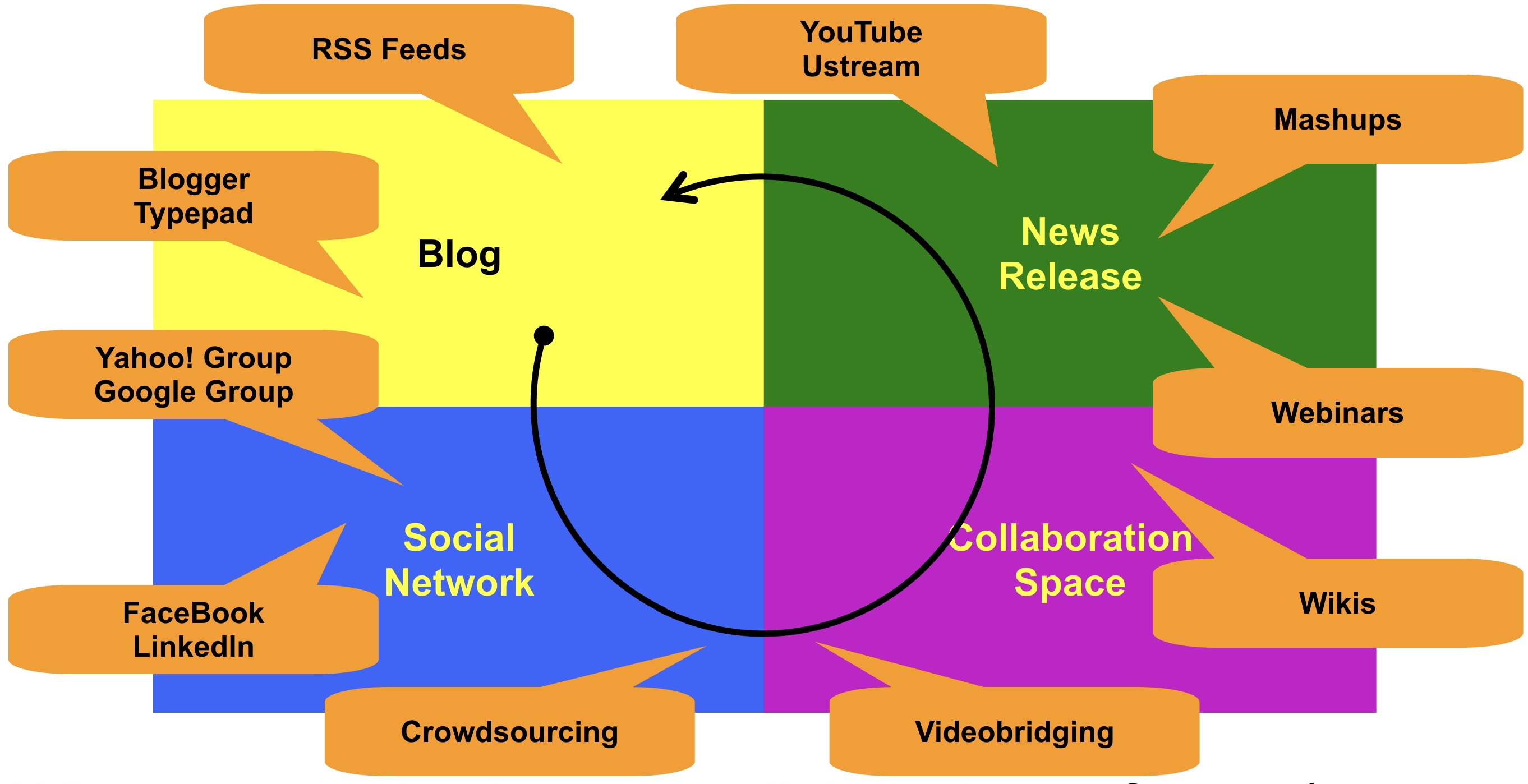Recently, several of us were going over the litany of new terms for communication and collaboration “tools” that were less than 10 years old: blogs, mashups, crowdsourcing, webinars, podcasts, etc. just to name a few. It became obvious as we discussed it further than many of us in the conversation were relatively clueless when it came to defining what each is, what it does, how it works, and what were the benefits. As in most instances where there are too many dots and no clear picture in mind to connect them; a framework would be helpful.
The quadrants and circular arrow in the diagram below illustrate a progressive path of organized social interactions. It starts with the blog: the primary virtual means by which an individual, almost any individual who has access to the Internet, announces to the world – here is who I am, what I think, and what I care about. It is a powerful statement of independent thought, self-awareness, and clarity of purpose that any blogger makes simply by posting a message.

When individuals put themselves out there, they are likely to be “discovered” by others who share common principles, interests, and affinities. One of the most likely places to be “found” is in a social network. In these far-ranging open communities individuals extend their connectivity, learn more about themselves and each other, strengthen their affiliations, and become more intentional about doing certain activities together rather than individually.
At this stage, groups engaging in some sort of purposeful collective effort benefit by having collaboration spaces for more efficient and effective teamwork. Here they can work openly among themselves to give projects definition, open their assumptions for testing and scrutiny to those beyond their team boundaries, and adapt the projects to what is learned for more successful and acceptable results.
Of course, such results warrant wider exposure in global networks. News releases are presented to a broader audience for further sponsorship, investment, or utilization–and feedback. Learning and adaptation are triggered on a broader scale. Quickly we know if what we are doing is having the intended result; do others believe in it as we do; what other steps can we take to increase the viability, and sustainability of our offering.
This is where the cycle returns full circle to the blog where further commentary and endorsement (or not) about the news release is made in the context of what is important to the blogger—and the cycle starts anew. Of course, beginning the next round means starting at a different place and time, having more experience, and making additional discoveries between rounds. These are multiple cycles that radiate out in a spiral model approach.
So how do the tools we have available fit into this communication and collaboration cycle? A few are highlighted in the picture below.

There are many nuances and subtleties to each stage of the cycle; and there are certainly MANY more examples of software and system tools that can be included. However, this should give you a feel for how the overall process functions.
Here’s an example for your consideration:
In 2001, Roger Beck, a teacher at Worthington Kilbourne High School in Worthington, Ohio, initiated a program called Building Academic Skills and Experiences (B.A.S.E.). B.A.S.E. integrates twelfth grade English, Government / Economics, and Technology Education. In 2004, this program was linked with Habitat for Humanity in a housing construction project called Home B.A.S.E. In his most recent blog postings, Mr. Beck outlines progress on the current 2006 – 2007 Home B.A.S.E. project – a LEED-certified home – that is now drawing to a close.
One of those groups whose members are very supportive of Roger and his team is a local Worthington social network named, Sustainable Worthington. An announcement to their members stated the following:
WKHS Home B.A.S.E. LEED house pilot project, 258 N. 21st Street, Columbus, OH, Saturday, September 22, 2007, 2:00 p.m.: Roger Beck, the teacher who developed this excellent program, will give us a tour of this amazing house, which offers green solutions to an amazing array of issues facing every homeowner. For a preview, go to where you will see great photos and an archive of the weekly project updates. Come to be educated and inspired!
When Mr. Beck and others initiated their most recent project last year, they sought volunteers in a number of collaborative spaces. This one, the Columbus Chapter of the Construction Specifics Institute, heralded the following headline:
COLUMBUS CSI CHAPTER INVITES YOU TO TAKE PART IN GIVING A HAND UP: Do a good deed, network with fellow CSI members and be part of building a pilot LEED home!
The attraction of volunteers to this project was based on past successes such as the one that ended in 2006 which was described in the news release1 following a public meeting for Green Energy Ohio in May 2006. It includes a link to a blog dedicated to the project.
The tour is today; I am participating. That will result in another blog posting – stay tuned…
Originally posted to New Media Explorer by Steve Bosserman on Saturday, September 22, 2007
- News release is no longer available online ↩